We use cookies to help better serve your experience. Accept Cookies
Salon
The Visual Representation of the US/Mexico Border Wall in the Media — The Reading the Pictures Salon
On December 6th, 2018, Reading the Pictures and the Magnum Foundation presented a unique online event.
By Michael ShawA year ago, Reading the Pictures won the Howard Chapnick Grant from the W. Eugene Smith Memorial Fund to do a Salon looking at the media framing of the US/Mexico border wall. We are grateful for their support.
Since 2010, Magnum Foundation has made more than 250 direct grants to photographers. Through production funds and project development assistance, it supports both emerging and recognized artists at various stages of their processes.
This project consisted of four parts: extensive photo research, a live panel discussion, a live audience discussion, and additional imagery and analysis posted on Instagram.
We examined over a thousand published photos from news wires and other media outlets. We organized those images into themes, including the Thickening Border; Pathways and Walls; Looking Through/Back/Out; Children; Protest & Power; and Cruel Looking. Ultimately, we selected nine photos, some familiar and some less so, which we felt best spoke to the themes, events, and the media representation. Of the nine images, we included one photo each from two acclaimed photographers covering the story who joined us in the salon.
In our online discussion, co-produced with the Magnum Foundation, an expert panel examined the visual depiction of the wall, and how photographers and the news media use imagery to frame the politics and the human rights issues surrounding the wall.
As part of the discussion, viewers were invited to participate in a live audience chat. We were pleased and excited that many of the photographers whose pictures we discussed also took part. You can see excerpts of those conversations below. A sampling of the photo analyzed and posted on Instagram appear below that.
We want to also pay a special thanks to our moderator and panelists, including:
Anne Demo, Assistant Professor, Communication Arts and Sciences, Penn State University (Moderator). Teddy Cruz, Architect, Professor of Public Culture and Urbanism, Visual Arts, UCSD. Fonna Forman, Associate Professor of Political Science / Co-Director, UCSD Center on Global Justice; Erin Siegal McIntyre, Senior Fellow at the Schuster Institute for Investigative Journalism; Nick Oza, Staff Photographer, Arizona Republic; Griselda San Martin, documentary photographer focusing on issues of immigration and identity; and Michael Shaw, Publisher, Reading The Pictures.
And special thanks to Meg Handler, Reading the Pictures Editor-at-Large and Christa Olson for photo research and creating our photo edit. Also warm appreciation to Pam Sullivan who produced the live program.
The Reading the Pictures Salon is an on-line, real-time discussion between photojournalists, visual scholars and other visual or subject experts. Each salon examines a set of images relevant to the visual stories of the day with a focus on the media and social media framing of a significant social issue. The photo edit is the key element and driver of each Salon discussion. These 9 photos are derived from an extensive review of the content and themes of published photos representing the depth and breadth of media representation
Highlight Clips
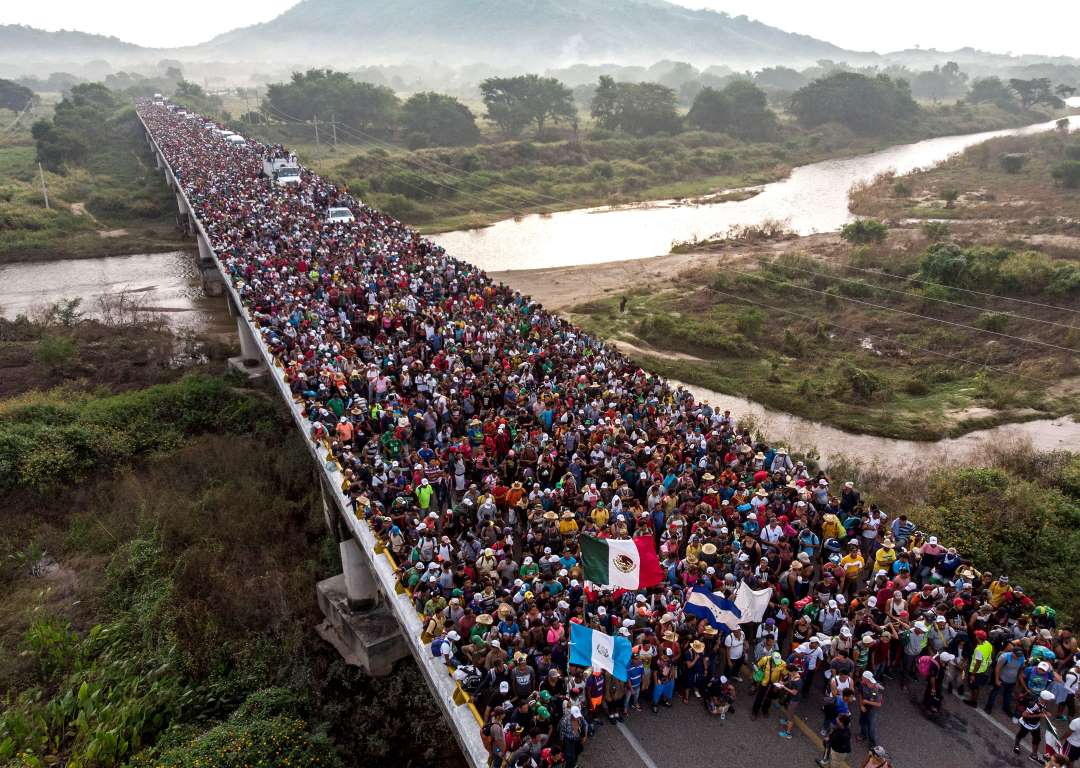
Honduran migrants caravan to the U.S.
In this highlight clip, panelists Erin Siegal McIntyre, Michael Shaw, Teddy Cruz, and Fonna Forman discuss the visual politics of this photograph of Honduran migrants in southern Mexico heading in a caravan to the United States. This image, and others like it, have been heavily leveraged in the US immigration debate.
Watch NowPhoto: Guillermo Arias /AFP/Getty Images
Caption: Aerial view of Honduran migrants heading in a caravan to the US, as the leave Arriaga on their way to San Pedro Tapanatepec, in southern Mexico on October 27, 2018. – Mexico on Friday announced it will offer Central American migrants medical care, education for their children and access to temporary jobs as long as they stay in two southern states.
Audience Chat
Stefan Falke: Unfortunately this great image of the caravan on the bridge is being used by the current administration for their cause, the wall
Pete Brook: If you want to see militaristic, you’ll see militaristic. If you want to see human rights protest march, you’ll see that.
Stefan Falke: @Alejandro Martinez our images can be used either way
Daniel Castro Garcia: This Guillermo Arias image is so similar to the images that were coming from Europe in 2015/2016 and Myanmar… this is exactly what Nigel Farage (then leader of British right-wing political party UKIP) used to completely manipulate the debate around migration.
Gregory Bull: I love the criss-cross of the people contrasted with the river
Guillermo Arias: This actually was the last time that the caravan was photographed together, way down south in Chiapas
Christa Olson: Also worth noting that these folks aren’t hoping to slip across the border undetected. They want to apply for asylum. Framing them as “illegal immigrants” omits their status as refugees, as @Alejandro Martinez points out
Pete Brook: “Walking shares with making and working that crucial element of engagement of the body and the mind with the world, of knowing the world through the body and the body through the world.” – Solnit
Carol Quirke: It is equally like Delacroix’s Victory leading the people. So it strikes me that there is always a liberal fear of the collective–this is what makes change too!
Gregory Bull: Guillermo has such a powerful body of work on the border. Years and years of amazing work from this very talented guy!
Alejandro Martinez: Guillermo is from the border.
Vannessa Falcon: Do you have any thoughts, reflections, quotes from the individuals from these images?
Carol Quirke: This is such a powerful image…akin to many images of strike lines in the 1930s, or even early war photos with that hard diagonal line. But the color of those in the caravan stands out against the mist…this could just as easily by a parade. So reading it as a scary mass says much about the context of the reader.
Guillermo Arias: I disagree, the flags tell you where they came from and also recognize Mexico as a host country.
Erin Siegal McIntyre: @anne That is not true. Many migrants are migrating for economic reasons. It is not correct to say everyone wants to ask for asylum.
Erin Siegal McIntyre: The caravan is a mixture of migrants who are moving or fleeing for various reasons.
Anne Demo: Thanks for the correction Erin! You are right.
Erin Siegal McIntyre: The Colegio de la Frontera Norte has just released the first study of the caravan demographics, based on the population of nearly 6000 who were sheltered at the Unidad Deportiva Benito Juárez
Christa Olson: but the invasion / marching focus tends to emphasize illicit migration rather than asylum
Alejandro Martinez: Also there are refugees below waiting for asylum and that’s not included in the caption.
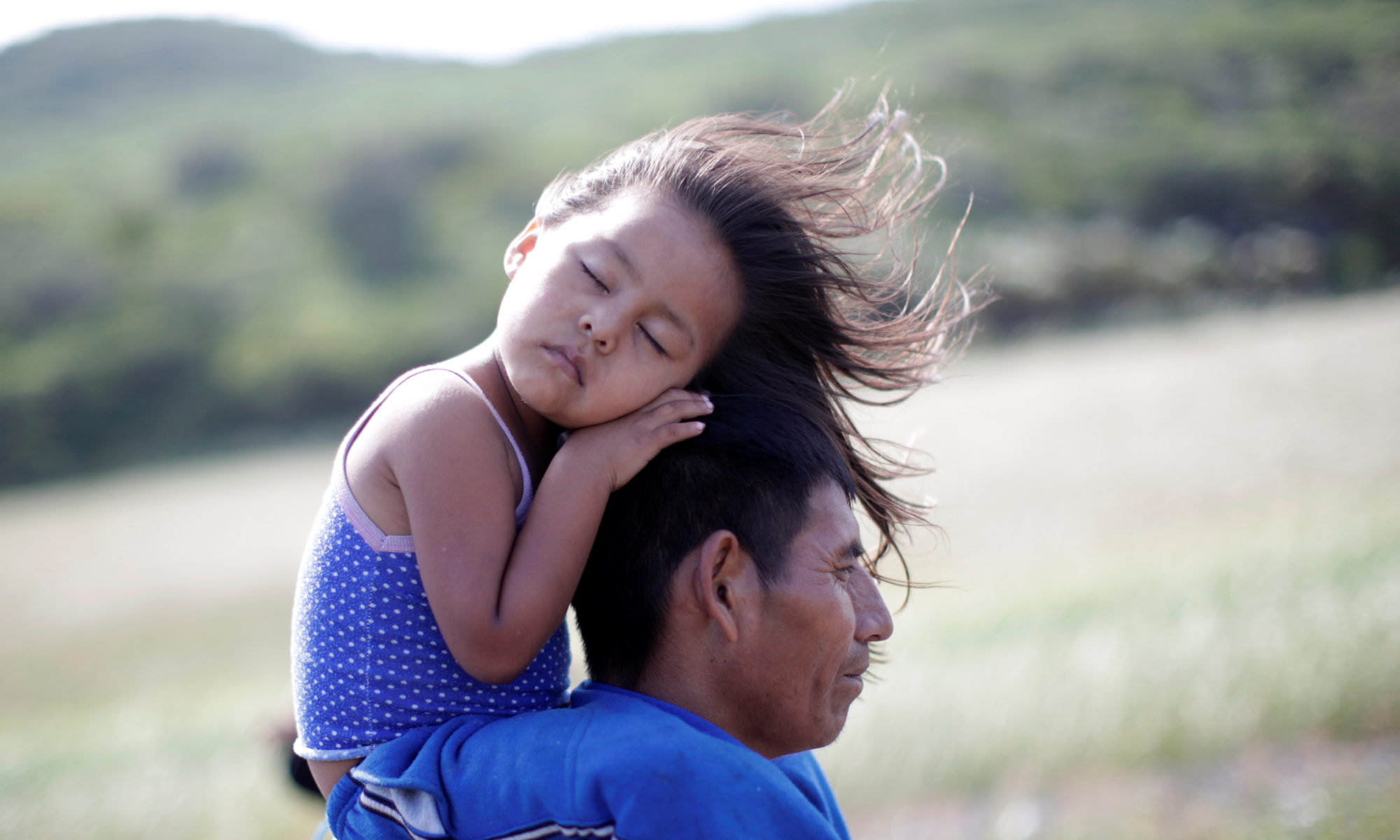
Migrant father and daughter
In this highlight clip, moderator Anne Demo and panelists Fonna Forman, Teddy Cruz, Michael Shaw and Erin Siegal McIntyre speak to the eloquence of a Guatemalan father and daughter crossing through Mexico as part of the recent refugee caravan en route to the United States.
Watch NowRosendo Noviega, a 38-year-old migrant from Guatemala, part of a caravan of thousands from Central America en route to the United States, holds his daughter Belinda Izabel as he walks along the highway to Juchitan from Santiago Niltepec, Mexico, October 30, 2018. REUTERS/Ueslei Marcelino
Audience Chat
Cara Finnegan: Erin’s point about the image “breaking through the noise” is so interesting precisely because the image is at the same time so very quiet.
Carol Quirke: the child’s innocence and vulnerability is akin to an Anne Geddes image. That contrast between a softer image with her hair and hands, and the man who looks so stalwart.
John Rountree: Think about Trump’s rhetoric of “They’re bringing.” Here, “They’re bringing” a young innocent girl.
Ada Luisa Trillo: The image is perfect, just perfect
Alejandro Martinez: Do you have any reflections or thoughts from the protagonist of the image?
Ueslei Marcelino: Each photograph has a little of each photographer. I am a father too, and I have imagined it a few times in his place.
Jeremie Bacpac Franko: I wish Rosendo could only know this photo was take. He is looking forward, moving forward…Where will they be in five years, to be able to look back at this photo?
Meg Handler: Thank you for joining us Ueslei!
Cara Finnegan: So great having the photographer of this image joining us in this chat!
Erin Siegal McIntyre: Jeremie, many of us photogs who have covered the caravan are able to WhatsApp images to subjects
Anne Demo: Yes! Thanks so much Ueslei! You had a different image on your instagram. It was also stunning.
Saam Aghevli: Are her nails painted?
Jeremie Bacpac Franko: Oh wow Erin, magnificent!
Erin Siegal McIntyre: Of course I can’t speak for this Reuters fotog, but I know those of us who aren’t filing for wires sometimes do this
Michael Shaw: Welcome Ueslei: it really is a powerful image. So glad you’re with us.
Alejandro Martinez: Why didn’t we include a caravaner in this panel?
Pamela Yates: Rosenda seems to be dreaming, and she’s telegraphing those dreams to us in the photo.And at this stage in the caravan (southern Mexico) there was still a lot of optimism that the “American Dream” was possible and they would be allowed to pass into the US
Christine Lorenz: She’s not photographed with the kind of eye that we are used to seeing turned to non-Western children.
John Rountree: Her sleeping is an interesting facet because sleep is associated with spaces that are home, and this child has no home. Yet, it’s also somewhat ordinary to see a child sleeping, so it’s a bit familiar and unfamiliar in that way.
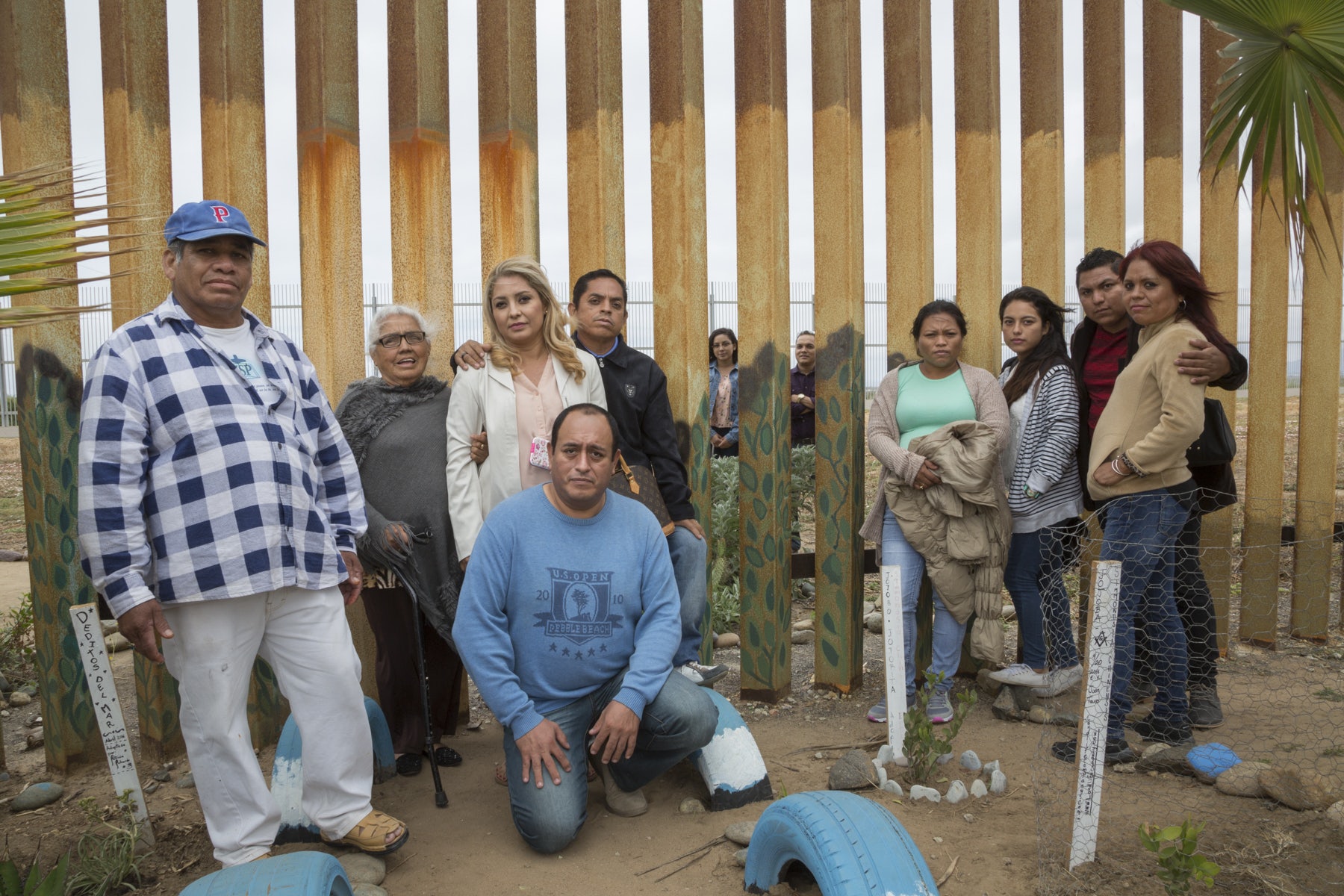
Family on two sides
In this highlight clip, panelists Griselda San Martin, Nick Oza, Michael Shaw, and Teddy Cruz, discuss San Martin’s exquisite portrait of a family physically and emotionally divided by the US/Mexico border wall.
Watch NowPhoto: Griselda San Martin
Caption: The Salgado family poses for a portrait. Cesar Salgado and his niece Giselle are on the American side of the fence. Cesar’s parents, siblings, and daughter (third from right) are on the Mexican side. This is the first time Cesar has seen his daughter in 14 years.
Audience Chat
Daniel Castro Garcia: @Griselda San Martin pretty mind blowing portrait!
Erin Siegal McIntyre: @Griselda San Martin when was this taken?
Alejandro Martinez: Friendship park is currently indefinitely closed due to the militarization at the border.
Gregory Bull: really like this picture. Any of us who have tried to document families divided by the wall understand the difficulties. This works really well for me!
Michael Shaw: Agree, Daniel. I have so many questions.
Alejandro Martinez: Covered in barbed wire.
Sandy Huffaker: They also only let 10 people in at a time which has severely limited the amount of families which can meet
Jeremie Bacpac Franko: Alejandro Martinez I am glad you’re in the house
Alejandro Martinez: @Jeremie Bacpac Franko BorderClick TASO and AJA Project are here. All comments are from a group of 8 people. Alejandro says “Hola!”
Carol Quirke: Beautiful photograph–love the reference to earlier forms of portraiture.
Muriel Hasbun: @Griselda San Martin Beautiful portrait and important perspective of, like you say, an extraordinary moment of ‘daily life’ –combating/reversing the objectifying and reductive narrative of (im)migrants as others. Bravo.
Alejandro Martinez: LOVE HAS NO BORDERS
Stefan Falke: the garden is on both sides, the binational garden
Erin Siegal McIntyre: @Stefan Falke and it looks much different now! It has grown so much in the past few years
Christine Lorenz: Being so invested in these images, it’s easy to forget how many millions of Americans have no grasp of the lives people like the Salgados live, have maybe never met any immigrants at all. (and those folks vote)
Tamar W. Carroll: It also conjures family visits in prisons
Ueslei Marcelino: What caught my attention in this photo, besides the beautiful portrait about immigration, that is not standardized photography, with differentiated technology. she is not perfect and accepting this is incredible. the two people in the picture are the big reason for the discussion
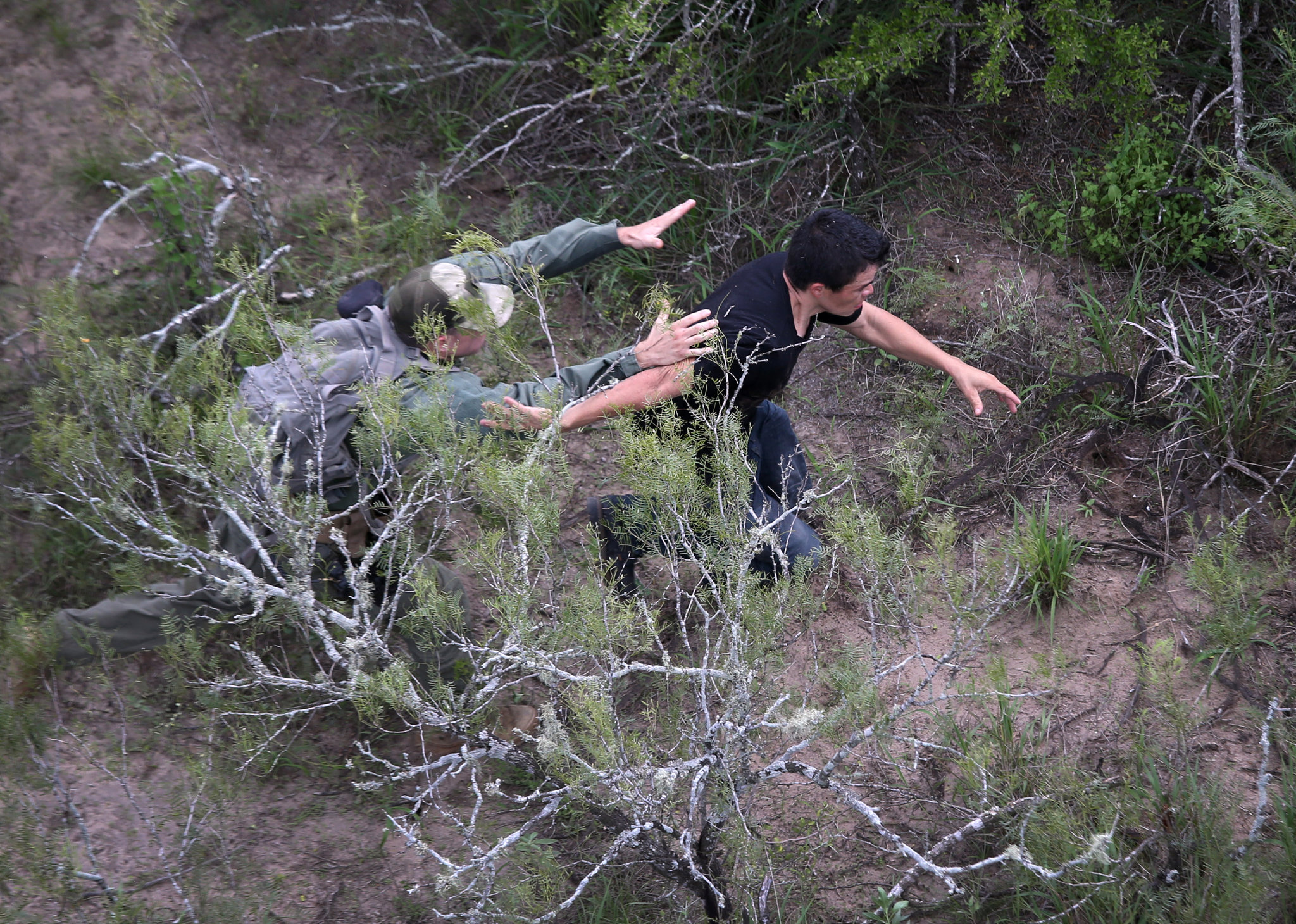
U.S. Border Patrol agent chases an undocumented immigrant
This photograph of a border agent chasing a migrant has been widely distributed. Panelists Fonna Forman, Griselda San Martin, and Teddy Cruz analyze the action and provide necessary context.
Watch NowPhoto by John Moore/Getty Images
Caption: A U.S. Border Patrol agent tries to tackle an undocumented immigrant in dense underbrush on September 9, 2014 near Falfurrias, Texas. He missed but the immigrant was later caught by a fellow agent. Thousands of migrants continue to cross illegally from Mexico into the United States, and Texas’ Rio Grande Valley has more traffic than any other sector of the U.S.-Mexico border.
Audience Chat
Alejandro Martinez: @sandy Huffaker Im not a photographer for a publication but as part of the community who lives and works here there is an influx of photographers capitalizing off of the “crisis” witnessing people get teargassed. Just a though on how photographers can also use their hands when they are “on the ground”
Alejandro Martinez: As active volunteers of Border Angels in San Diego this image makes our stomachs hurt. We could not at all imagine taking a photograph while this was happening. We would be doing everything in our power to make sure this migrant was safe.
Alejandro Cegarra: We are photographers, not Border Angels, each one of us have a different role
Andrés Rafael Luévano: John Moore was there at the migrant encampment in Tijuana when they arrived.
Fonna Forman: Powerful comment, Alejandro…. I am not a photographer, but you raise an interesting point about bystanding
Alejandro Martinez: Thank you @Fonna Forman
Alejandro Cegarra: We can’t not always intervene…
Guillermo Arias: Don’t forget Alejandro that photographers also get gas, pass cold, get hit..etc. The difference between a photojournalist and an activist is the public trust photojournalist work is going to be as fair and just as possible, other wise is biased and public can’t make their own judgement.
Alejandro Martinez: We are published photographers and published journalists. We can speak on these roles.
Alejandro Cegarra: @Guillermo arias Maestro! un placer verlo por acá
Christa Olson: @Griselda San Martin that was *exactly* my thought. Border agent = zombie
Steven Wilner: But, Alejandro, that is not the role of the documentary photographer. If they had tried to do that the world would not know about the horrors. that is why we need both photographers and Border Angels!
Pamela Yates: It makes me consider this defining moment. Will all of the money spent and hardships endured end right now? Or will he get away? That’s why it’s better to look at the photo before considering the caption sometimes.
Guillermo Arias: Abrazo Alex
Jeremie Bacpac Franko: JUST TO QUESTION, these photos are of course heart-wrenching but they are sympathetic with the horrific situation; I was under the impression from the title of the webinar that you’d be discussing how FOX NEWS or others (newspapers, etc) show how kindly the government is treating people…how “nice” the ICE facilities are..children playing, etc. The misleading propaganda …
Alejandro Martinez: @Guillermo arias Saludos Guillermo – BorderClick
Alejandro Martinez: The border is not a spectacle.
Stefan Falke: Unfortunately the border is a spectacle right now and will be forgotten by most soon
Stefan Falke: important to keep photographing there longterm
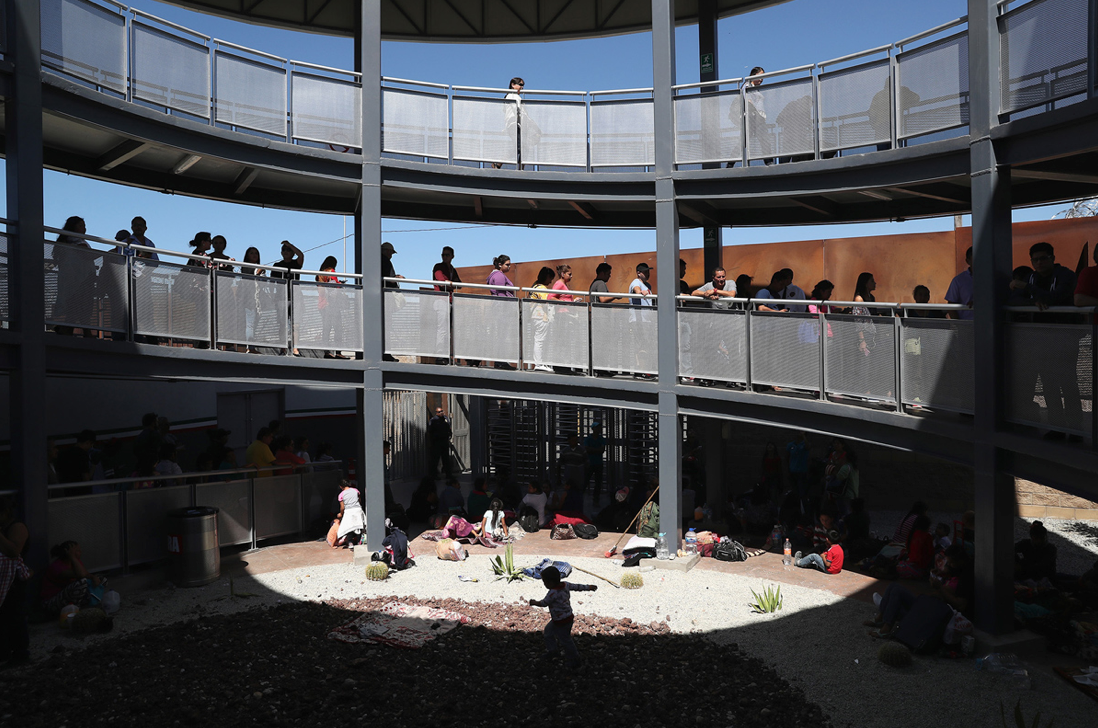
Line to cross legally into the U.S. from Mexico
The design of this pathway between Tijuana and San Diego, as well as John Moore’s photograph of it, are surprisingly informative. Panelists Teddy Cruz and Fonna Forman illuminate both.
Watch NowPhoto: John Moore/Getty Images
Caption: People stand in line to cross legally into the United States from Mexico on September 24, 2016 in Tijuana, Mexico. Securing the border and controlling illegal immigration have become key issues in the U.S. Presidential campaign.
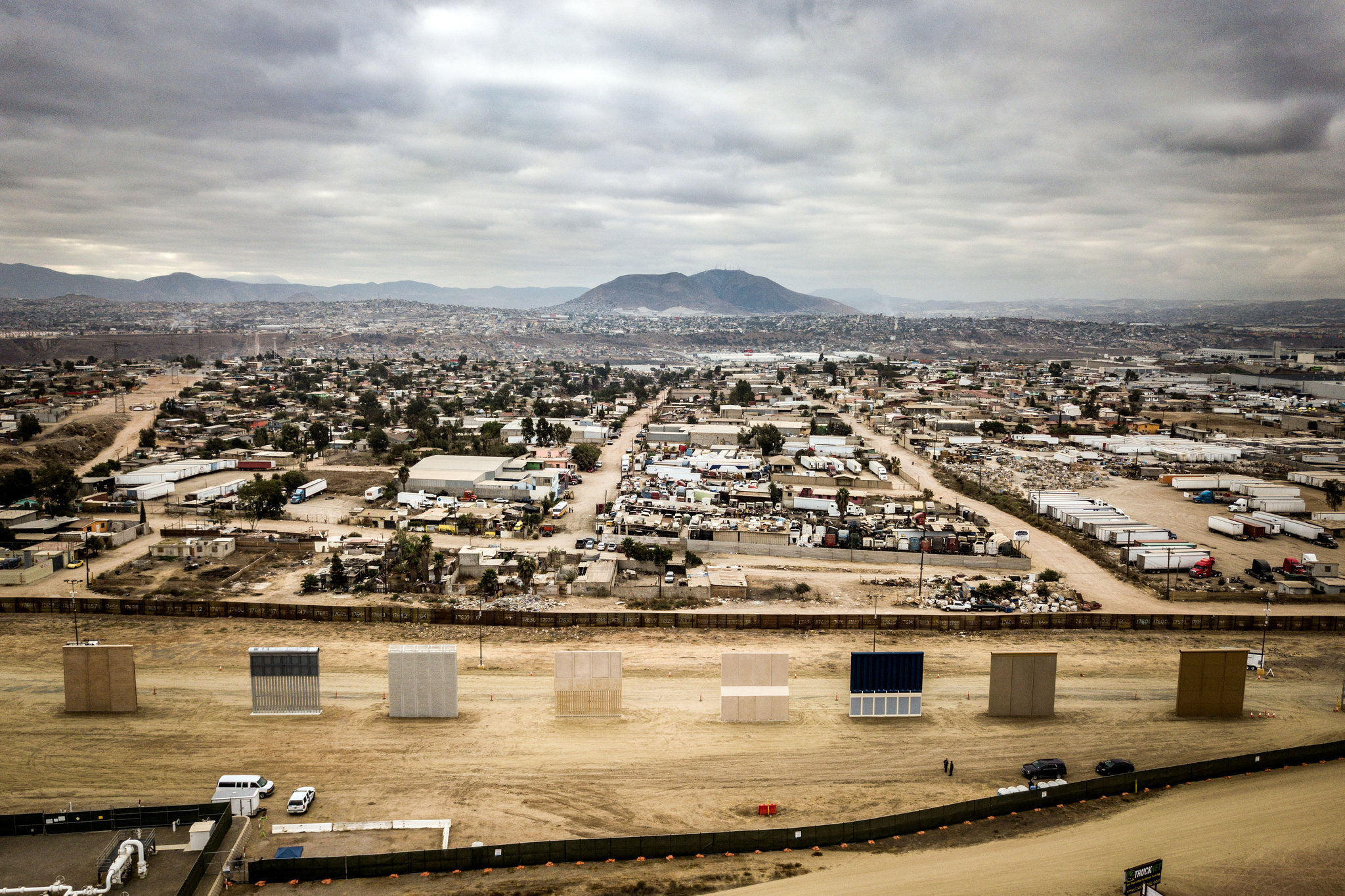
Border wall prototypes
Looking at this photo of the US government’s border wall prototypes, panelists Fonna Forman, Teddy Cruz, and Griselda San Martin discuss the visual dynamics of the aerial photo, and the physical and political implications of the proposed structures.
Watch NowPhoto: Josh Haner/ New York Times
Caption: Eight border wall prototypes on the United States-Mexico border in Otay Mesa neighborhood of San Diego. Christoph Büchel, a Swiss-Icelandic artist, has proposed the group be protected as a national monument.
Audience Chat
Daniel Castro Garcia: Agree with Teddy Cruz here! This is not art
Carol Quirke: It says national monument. It can be understood as akin to the monument against lynching. This is our horrible racist history.
Saam Aghevli: I disagree with Teddy, I think calling this art IS subversive and calls into question the act of building walls
Erin Siegal McIntyre: Definitely, Carol. This is part of our national history as Americans… like it or not, it’s who we are, today, in this moment.
Cara Finnegan: Teddy has a great point about the valuable functions of an aerial view.
Andrés Rafael Luévano: I am assuming Josh Haner’s photograph was taken with a drone. Correct? There is no higher ground at this location.
John Rountree: I feel like I haven’t seen many comparisons to the Berlin wall in public discourse. Has public memory on it simply faded away?
Christine Lorenz: Dictators love monuments … maybe it will take some time for us to be able to see these walls as a monument (and then we’ll have to decide what to do with it) (thinking optimistically)
Andrés Rafael Luévano: There is a fundamental difference with the Berlin Wall. It was constructed to keep people in, the US-Mexican Wall is proposed to keep people OUT.
Steven Wilner: Why not protect as a monument to never again much like the monuments in Hiroshima or Holocaust remembrances? A reminder of its inefficacy, small mindedness and hate? I respectfully disagree with Teddy on this point.
John Rountree: True, but there’s still a powerful comparison to be made, I think, about creating violent divisions.
Carol Quirke: The photo brings up the famous images of Hitler,by Reifensteil I think, of the soldiers facing him…in this there are these horrible walls as sentinels…but of what sort.
Guillermo Arias: It is a monument to ignorance and political gain.
Christine Lorenz: Yes! In the photographs, the walls look like tile samples, they look silly
Andrés Rafael Luévano: No one can get near the proto-types on the US side, on the Mexican side you can get right up to the border wall bars and shoot a photo through them. I was there last week and did it.
Steven Wilner: Exactly the reason to memorialize. It shows the absurdity of it. It is a powerful message
Christa Olson: I also like in this photograph that we’re looking it as if we’re wanting to cross into Mexico. The U.S. side is a wasteland, the Mexican side is life-filled.
Jennifer Deseo: I agree with Griselda: scale makes the wall samples look small and insignificant compared with the city, hill and sky in the mid- and background.
Andrés Rafael Luévano: This US side is an illusion. It is blocked off by the US Government, so that protesters cannot get near it.
Christine Lorenz: They have to protect the wall from Americans … that is kind of hilarious
Pete Brook: Resemble: drive-thru cinema (think Misrach’s “Desert Cantos”); air conditioning units; teeth; crenelations; lego bricks; cubicle dividers.
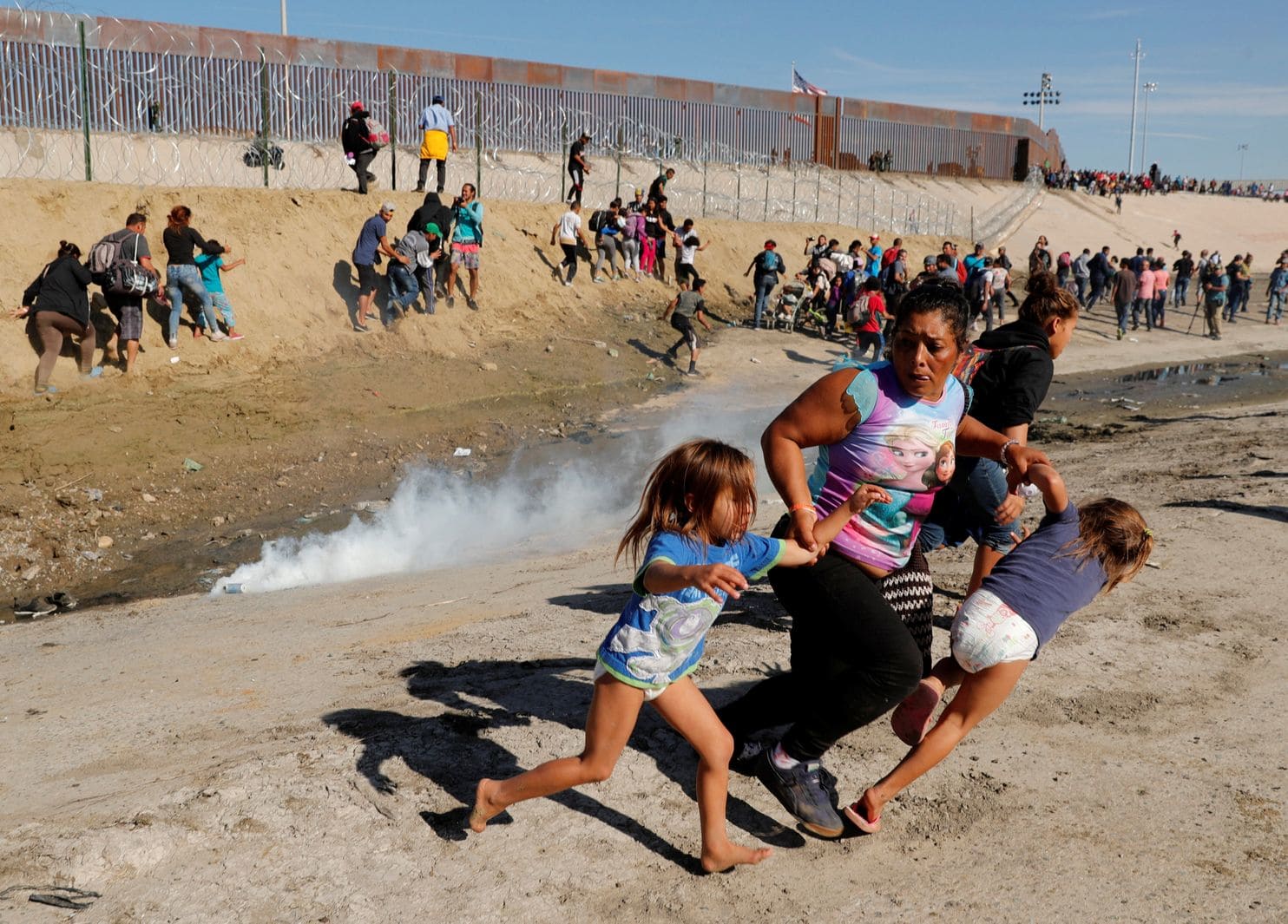
Migrant woman runs away from tear gas with her daughters
In this highlight clip, panelists Griselda San Martin and Teddy Cruz discuss the news value, and the political implications of this widely-published tear gas attack on asylum seekers.
Watch NowPhoto: Kim Kyung-Hoon/Reuters
Caption: Maria Lila Meza Castro, center, a 39-year-old migrant woman from Honduras, runs away from tear gas with her 5-year-old twin daughters Saira Nalleli Mejia Meza, left, and Cheili Nalleli Mejia Meza at the border wall between the U.S. and Mexico, in Tijuana on Nov. 25, 2018.
Audience Chat
Stefan Falke: Unfortunately this great image of the caravan on the bridge is being used by the current administration for their cause, the wall
Pete Brook: If you want to see militaristic, you’ll see militaristic. If you want to see human rights protest march, you’ll see that.
Stefan Falke: @Alejandro Martinez our images can be used either way
Daniel Castro Garcia: This Guillermo Arias image is so similar to the images that were coming from Europe in 2015/2016 and Myanmar… this is exactly what Nigel Farage (then leader of British right-wing political party UKIP) used to completely manipulate the debate around migration.
Gregory Bull: I love the criss-cross of the people contrasted with the river
Guillermo Arias: This actually was the last time that the caravan was photographed together, way down south in Chiapas
Christa Olson: Also worth noting that these folks aren’t hoping to slip across the border undetected. They want to apply for asylum. Framing them as “illegal immigrants” omits their status as refugees, as @Alejandro Martinez points out
Pete Brook: “Walking shares with making and working that crucial element of engagement of the body and the mind with the world, of knowing the world through the body and the body through the world.” – Solnit
Carol Quirke: It is equally like Delacroix’s Victory leading the people. So it strikes me that there is always a liberal fear of the collective–this is what makes change too!
Gregory Bull: Guillermo has such a powerful body of work on the border. Years and years of amazing work from this very talented guy!
Alejandro Martinez: Guillermo is from the border.
Vannessa Falcon: Do you have any thoughts, reflections, quotes from the individuals from these images?
Carol Quirke: This is such a powerful image…akin to many images of strike lines in the 1930s, or even early war photos with that hard diagonal line. But the color of those in the caravan stands out against the mist…this could just as easily by a parade. So reading it as a scary mass says much about the context of the reader.
Guillermo Arias: I disagree, the flags tell you where they came from and also recognize Mexico as a host country.
Erin Siegal McIntyre: @anne That is not true. Many migrants are migrating for economic reasons. It is not correct to say everyone wants to ask for asylum.
Erin Siegal McIntyre: The caravan is a mixture of migrants who are moving or fleeing for various reasons.
Anne Demo: Thanks for the correction Erin! You are right.
Erin Siegal McIntyre: The Colegio de la Frontera Norte has just released the first study of the caravan demographics, based on the population of nearly 6000 who were sheltered at the Unidad Deportiva Benito Juárez
Christa Olson: but the invasion / marching focus tends to emphasize illicit migration rather than asylum
Alejandro Martinez: Also there are refugees below waiting for asylum and that’s not included in the caption.
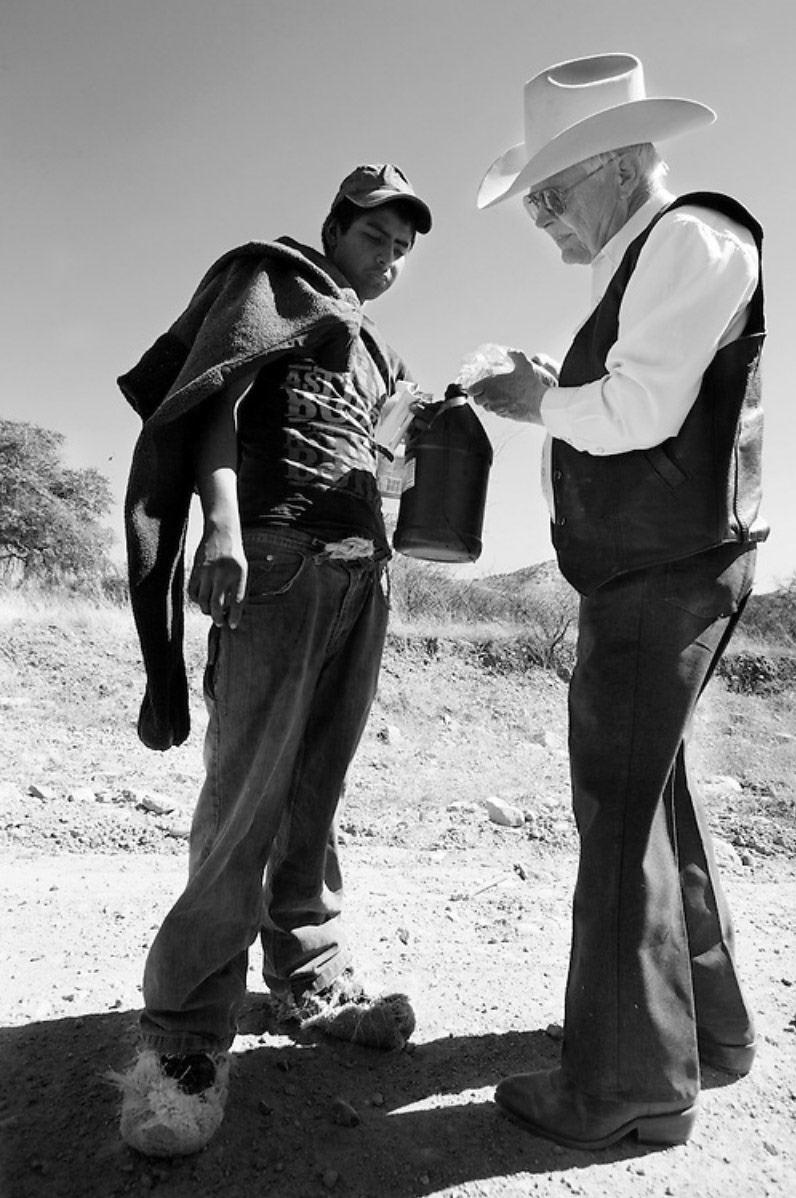
Rancher offers water to border crosser
Photographer Nick Oza discusses his photograph of Jim Chilton, an Arizona rancher, and 15 year-old Ivan Rebollar, a Mexican migrant taken eight miles north of the border, Oza describes the youth’s circumstances and how Chilton’s act of kindness defies political and media stereotypes.
Watch NowPhoto: Nick Oza/Arizona Republic
Caption: March 7, 2013. Rancher Jim Chilton offers water to Ivan Rebollar, 15, who said he’d been walking for two days without food or water since crossing the border. Chilton encountered Rebollar on Tres Bellotas Road, about eight miles north of the Mexico border. Rebollar, wearing carpet overshoes often used by drug smugglers, was walking south, towards Mexico, at the time. Rebollar, from a small town in Michoacan, Mexico, said he was looking for the Border Patrol to give himself up.
The Full Edit
Take a closer look at some of the images from our larger photo edit.


Photo: Ueslei Marcelino/Reuters
Caption: Rosendo Noviega, a 38-year-old migrant from Guatemala, part of a caravan of thousands from Central America en route to the United States, holds his daughter Belinda Izabel as he walks along the highway to Juchitan from Santiago Niltepec, Mexico, October 30, 2018


Photo: Josh Haner/ New York Times
Caption: Eight border wall prototypes on the United States-Mexico border in Otay Mesa neighborhood of San Diego. Christoph Büchel, a Swiss-Icelandic artist, has proposed the group be protected as a national monument.


Photo: John Moore/Getty Images
Caption: A U.S. Border Patrol agent tries to tackle an undocumented immigrant in dense underbrush on September 9, 2014 near Falfurrias, Texas. He missed but the immigrant was later caught by a fellow agent. Thousands of migrants continue to cross illegally from Mexico into the United States, and Texas’ Rio Grande Valley has more traffic than any other sector of the U.S.-Mexico border.


Photo: Nick Oza/Arizona Republic
Caption: March 7, 2013. Rancher Jim Chilton offers water to Ivan Rebollar, 15, who said he’d been walking for two days without food or water since crossing the border. Chilton encountered Rebollar on Tres Bellotas Road, about eight miles north of the Mexico border. Rebollar, wearing carpet overshoes often used by drug smugglers, was walking south, towards Mexico, at the time. Rebollar, from a small town in Michoacan, Mexico, said he was looking for the Border Patrol to give himself up.


Photo: Griselda San Martin
Caption: The Salgado family poses for a portrait. Cesar Salgado and his niece Giselle are on the American side of the fence. Cesar’s parents, siblings, and daughter (third from right) are on the Mexican side. This is the first time Cesar has seen his daughter in 14 years.
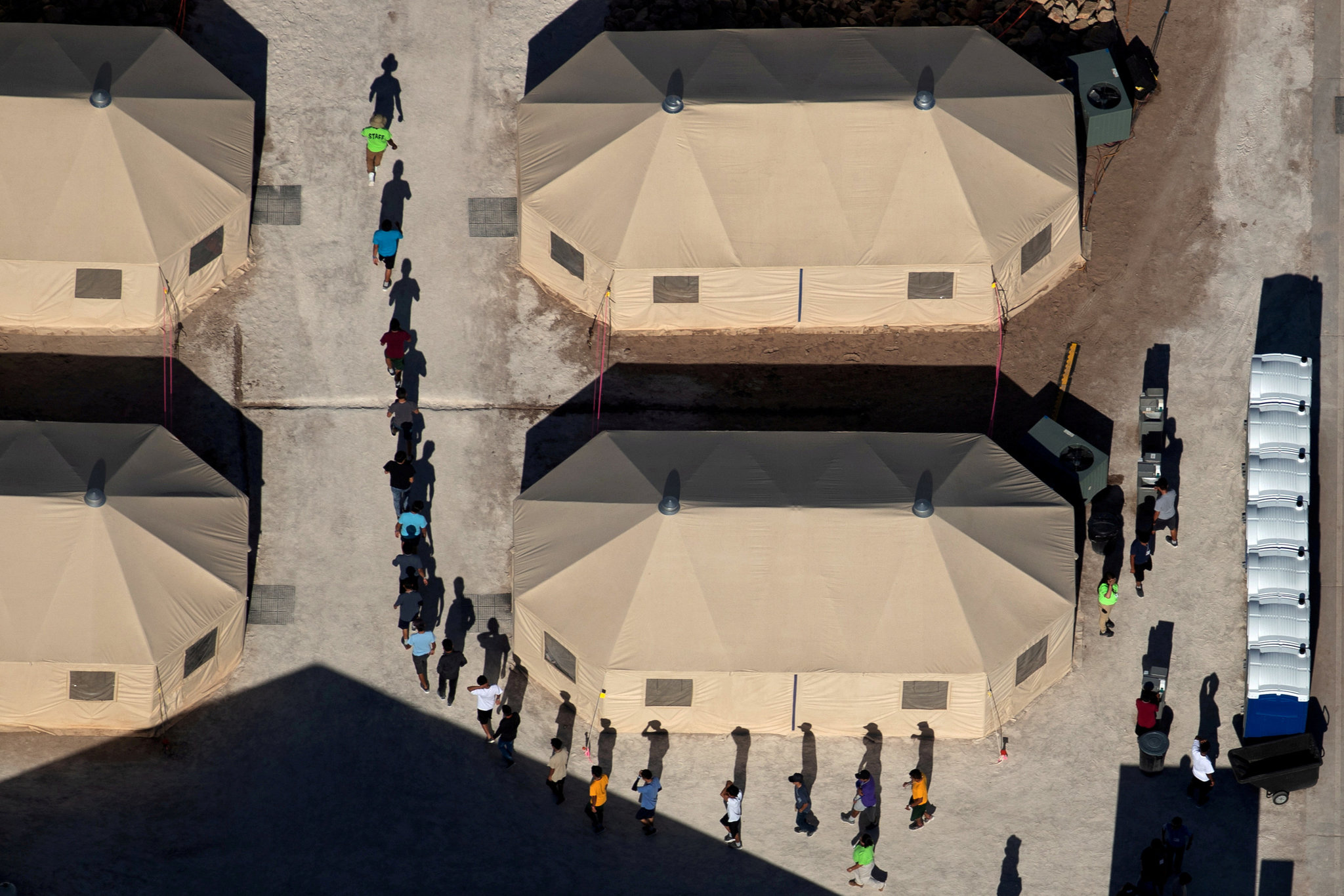

Photo: Mike Blake/Reuters
Caption: Immigrant children, suspected of illegal border crossings, are led by staff in single file between tents at a detention facility next to the Mexican border in Tornillo, Texas, June 18, 2018. It was not immediately clear whether these “unaccompanied minors” were apprehended without adults or separated from parents under a “zero tolerance” policy by the Trump administration. REUTERS/Mike Blake. NYT caption: Migrant children at a detention facility in Tornillo, Texas.


Photo: Guillermo Arias /AFP/Getty Images
Caption: Aerial view of Honduran migrants heading in a caravan to the US, as the leave Arriaga on their way to San Pedro Tapanatepec, in southern Mexico on October 27, 2018. – Mexico on Friday announced it will offer Central American migrants medical care, education for their children and access to temporary jobs as long as they stay in two southern states.


Photo: John Moore/Getty Images
Caption: People stand in line to cross legally into the United States from Mexico on September 24, 2016 in Tijuana, Mexico. Securing the border and controlling illegal immigration have become key issues in the U.S. Presidential campaign.


Photo: Kim Kyung-Hoon/Reuters
Caption: Maria Lila Meza Castro, center, a 39-year-old migrant woman from Honduras, runs away from tear gas with her 5-year-old twin daughters Saira Nalleli Mejia Meza, left, and Cheili Nalleli Mejia Meza at the border wall between the U.S. and Mexico, in Tijuana on Nov. 25, 2018.


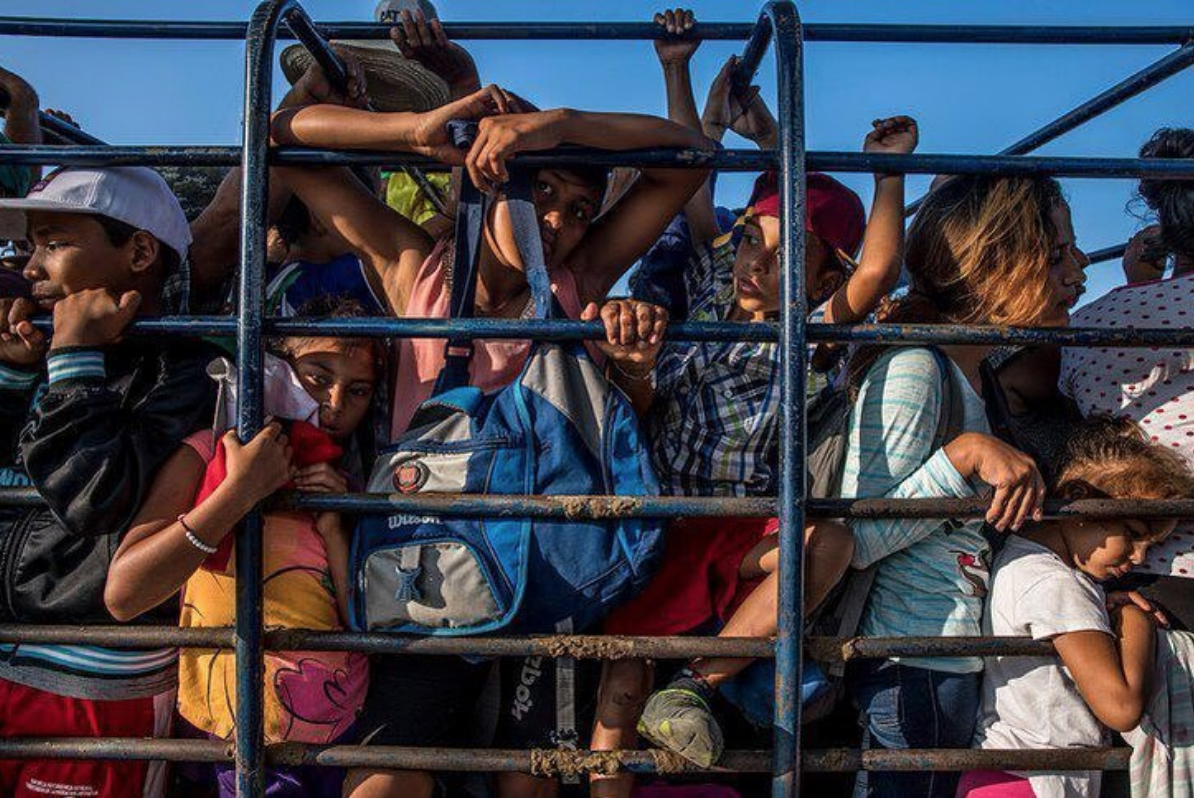

From Instagram: What’s so powerful about this photo by Adriana Zehbrauskas illustrating a recent New Yorker story on “the caravan”? It’s the way it pivots off the political talk criminalizing the Honduran refugees heading north. Call it: freedom ride vs. behind bars.⠀(Michael Shaw)
Photo: Adriana Zehbrauskas for the New Yorker, Children at the border, from Jonathan Blitzer’s dispatch “The Migrant Caravan Reaches a Crossroads in Southern Mexico.
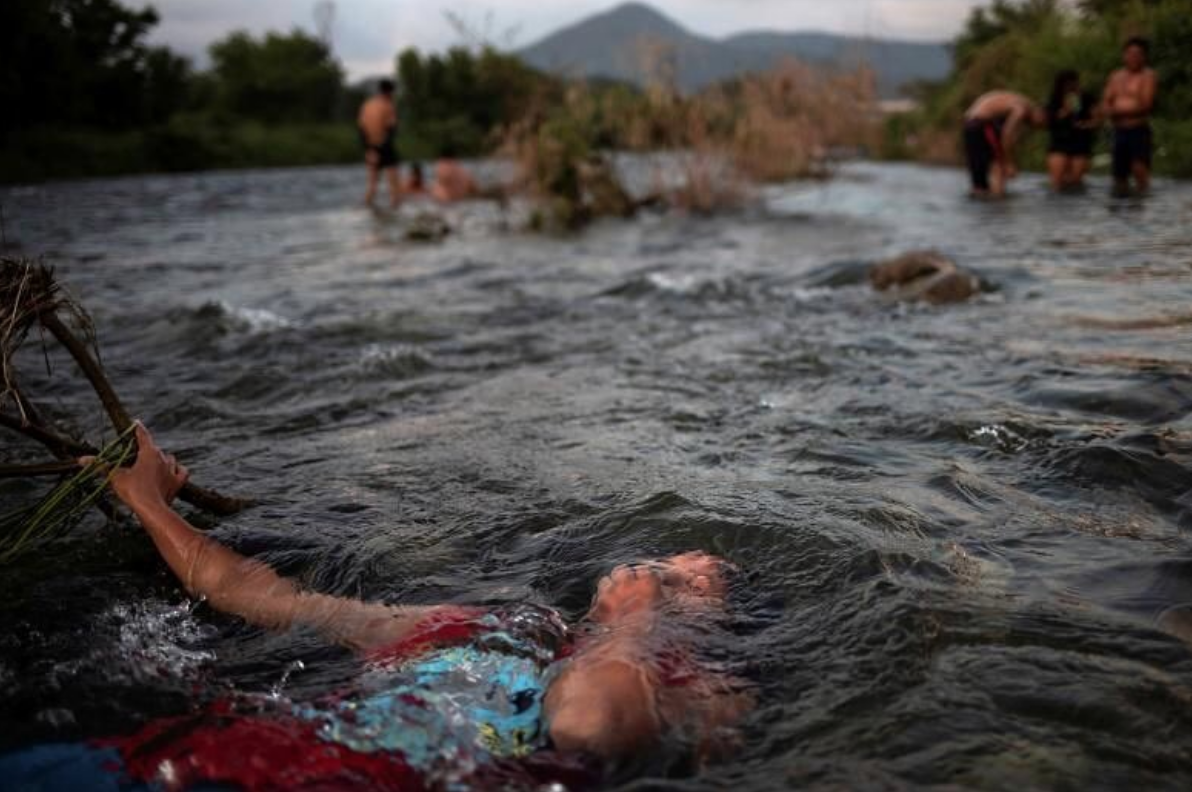

From Instagram: Children are a major theme in border wall, immigrant detention and caravan photos. Take this shot from a 32 photo slideshow Reuters just published titled: “Children of the caravan.” Of course, this is also a perfect example of the tension in migrant news photos and their different interpretation since the issue became such a political football. Here, for example, you’re pretty sure Jensi, a 14-year-old migrant from Honduras, is enjoying this freshwater stream in Pijijiapan, Mexico, before the caravan picks up again. But she could also be drowning. (Michael Shaw)
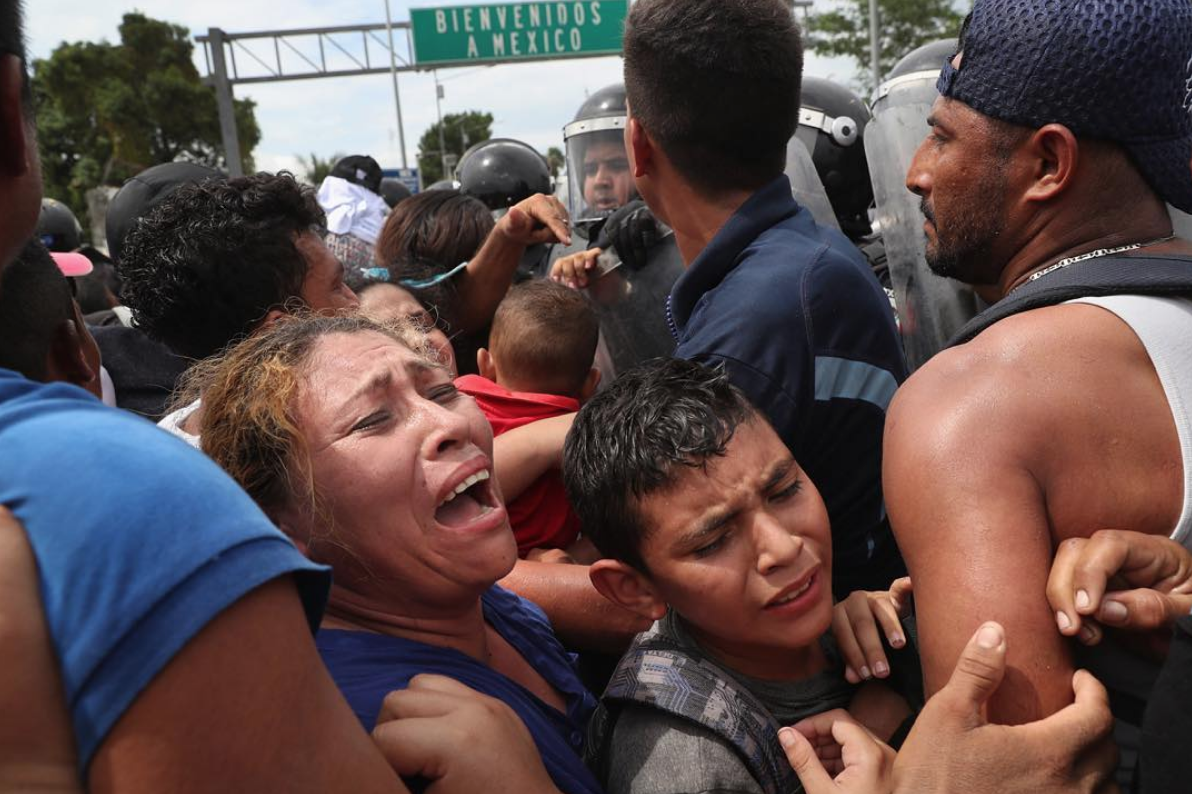

From Instagram: Thickening borders is one of the themes we’ve been looking at. The “invasion” rhetoric assumes that America’s border is completely porous and that migrants are one step away. Instead, John Moore’s photo shows these Hondurans just fighting to get into Mexico. Everywhere refugees go, the border follows them, and its representatives certainly aren’t saying “welcome.” (Christa J. Olson)
Photo: John Moore/ Getty Images Caption: Members of the migrant caravan are pushed forward into Mexican riot police on the border between Mexico and Guatemala on October 19, 2018 in Ciudad Tecun Uman, Guatemala. The clash occurred when the caravan of thousands of migrants tried to enter Mexico, crossing over the international bridge after pushing past Guatemalan security forces. The caravan tried to open the gate into Mexico but was pushed back by Mexican riot police. Some immigrants threw stones at police who then fired tear gas into the crowd.
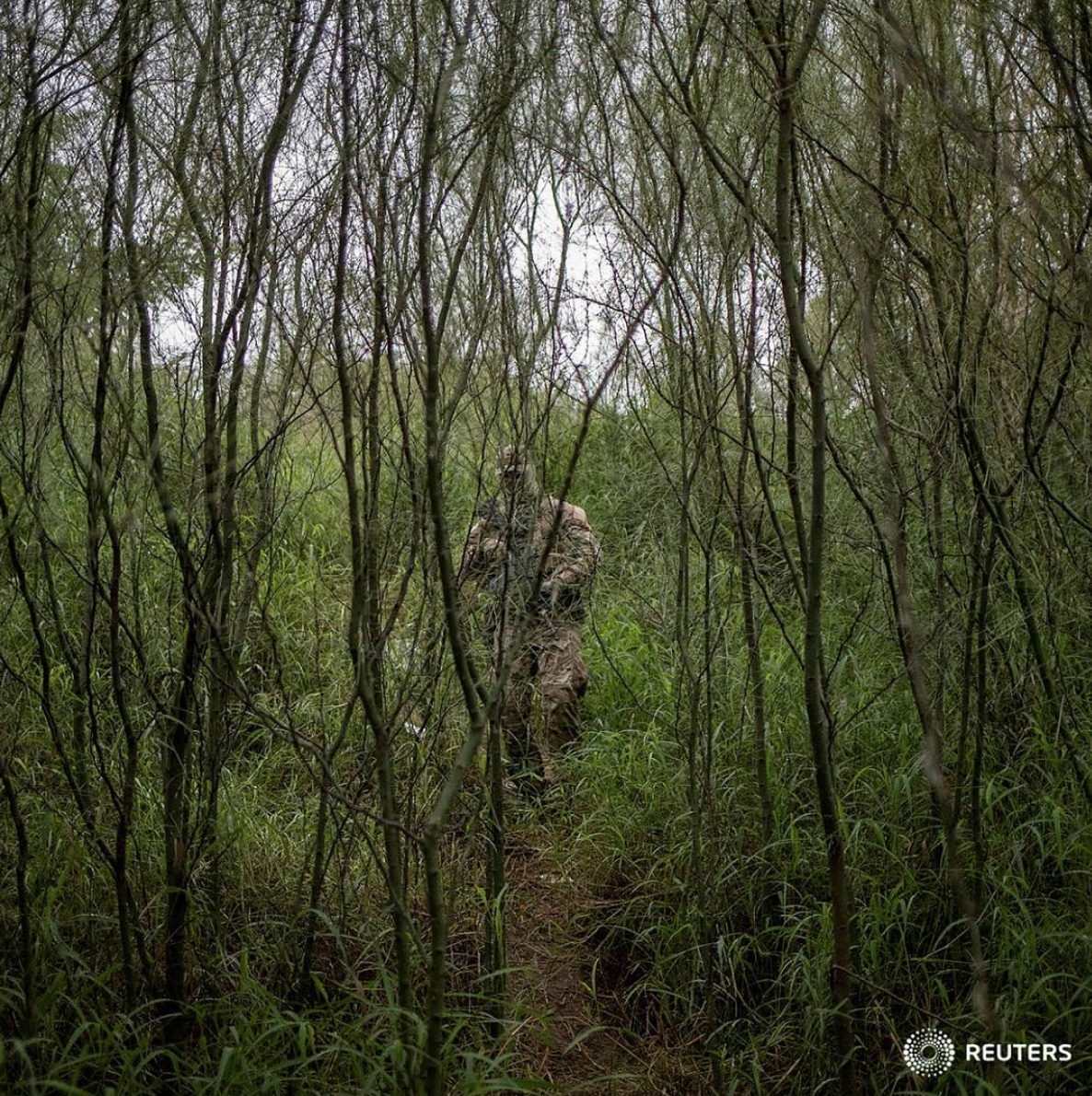

From Instagram: As politicians increasingly use the border to stoke fear, and the border becomes increasingly militarized, we see more news photos like this. Specifically, it’s an agent with the Border Patrol Tactical Unit searching a pathway near the Rio Grand used by families who cross From Mexico into Texas. Visually and emotionally, what it conjures up–with the cammo, the firepower, in the deep brush–is the hunter and the hunted.⠀(Michael Shaw)
Photo: Andrees Laif/ Reuters Caption: An agent with the U.S. Border Patrol Tactical Unit BORTAC searches a pathway near the Rio Grand river used by families who illegally cross into the United States from Mexico in Fronton, Texas October 18, 2018.
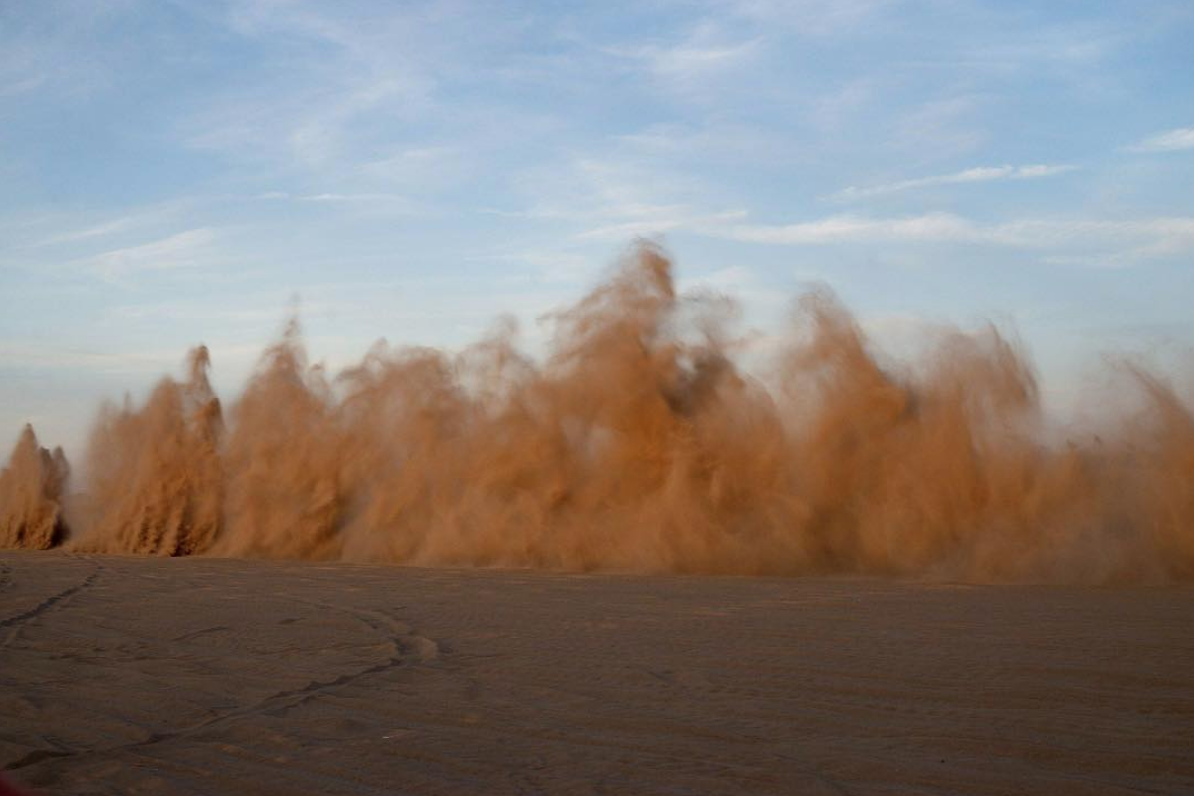

From Instagram: Beautiful, isn’t it? The photo of a sandstorm in Glamis, California, taken by Carolyn Drake, appeared in a New Yorker article titled: “Haunted Photographs of America’s Borderlands.” But how does the photo relate to the actual border, especially in the middle of the current political storm? Increasingly, photographers are using things that aren’t the actual border wall to invoke the wall. And in this case, it’s a metaphor for a “thickening border” in photographic form. (Christa J. Olson) ⠀
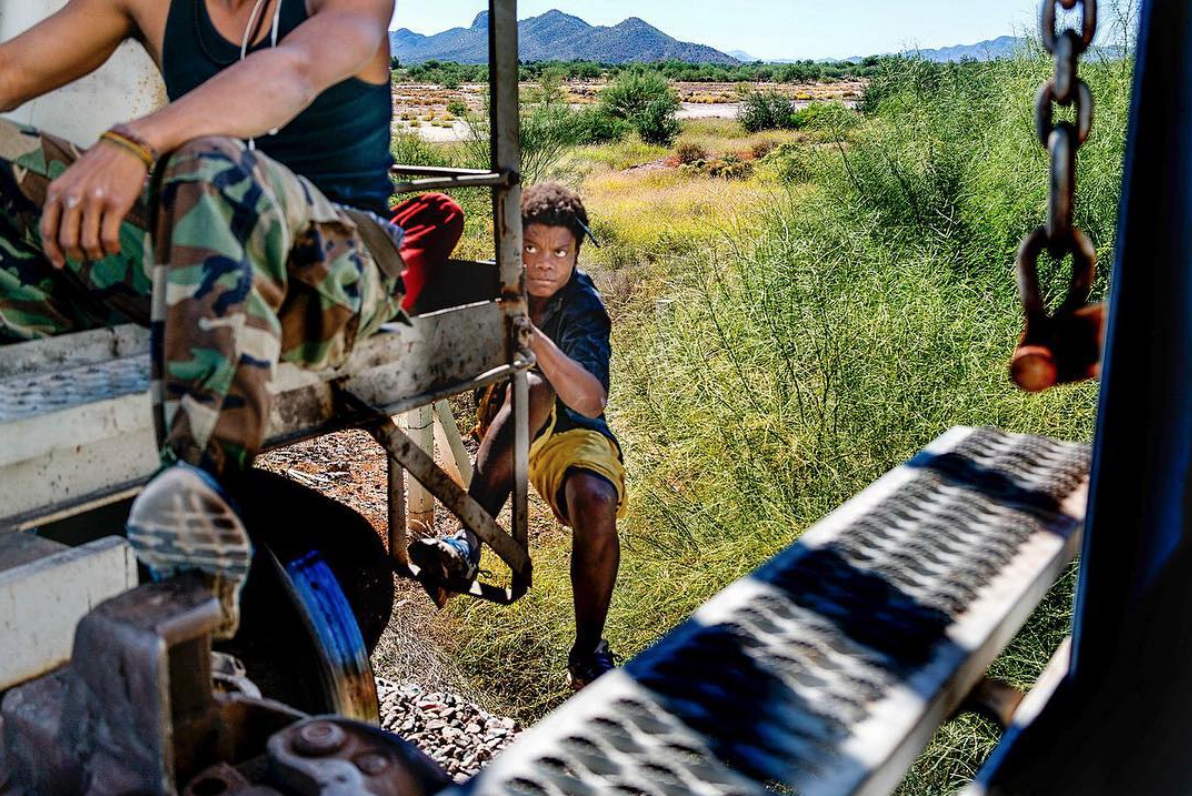

From Instagram: We’ve seen dozens of images of asylum seekers crammed atop of the trains referred to as “La Bestia,” or “The Beast”. These trains, packed to the gills, are incredibly dangerous to travel on. This frame by Nick Oza reflects the individual determination to get to the top, to keep moving north. And because it was taken in late October–at the height of America’s election caravan frenzy– it carries an extra charge. (Meg Handler)
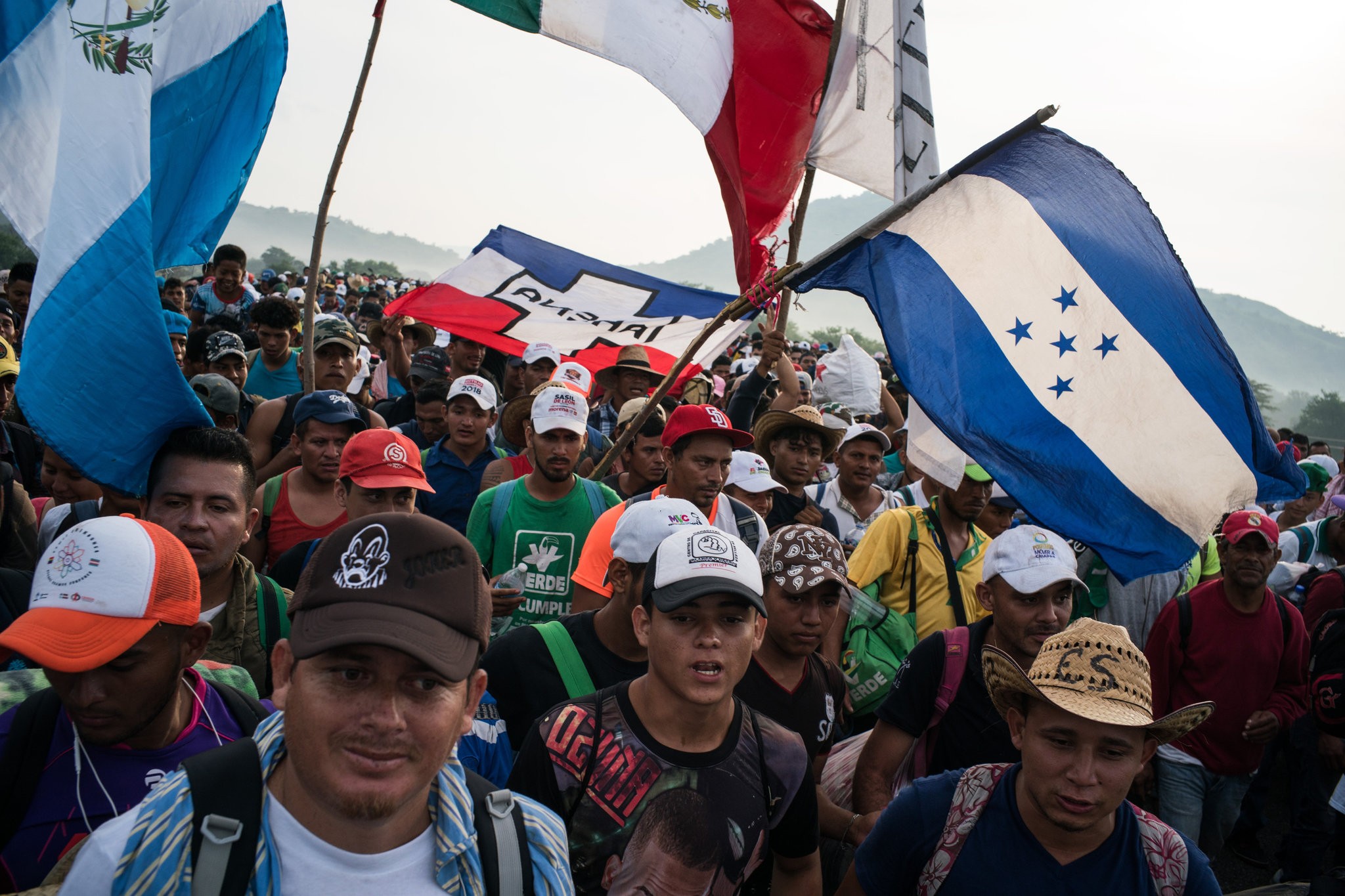

From Instagram: Flag waving, plus the use of war and military terms, is a powerful combo. So, when the media says migrants are “marching” and shows someone waving a Honduran flag, they pick up a tone set by the president that treats migration in terms of nationalism and a threat to the nation. Given the political frame, such pictures encourage us to see migrants as militants and to see militants as invaders. And an innocuous photograph becomes an American call to action. (Christa J. Olson)
Photo: Todd Heisler/The New York Times Caption: President Trump has deployed thousands of troops to prevent a Honduran caravan from crossing the southern border.
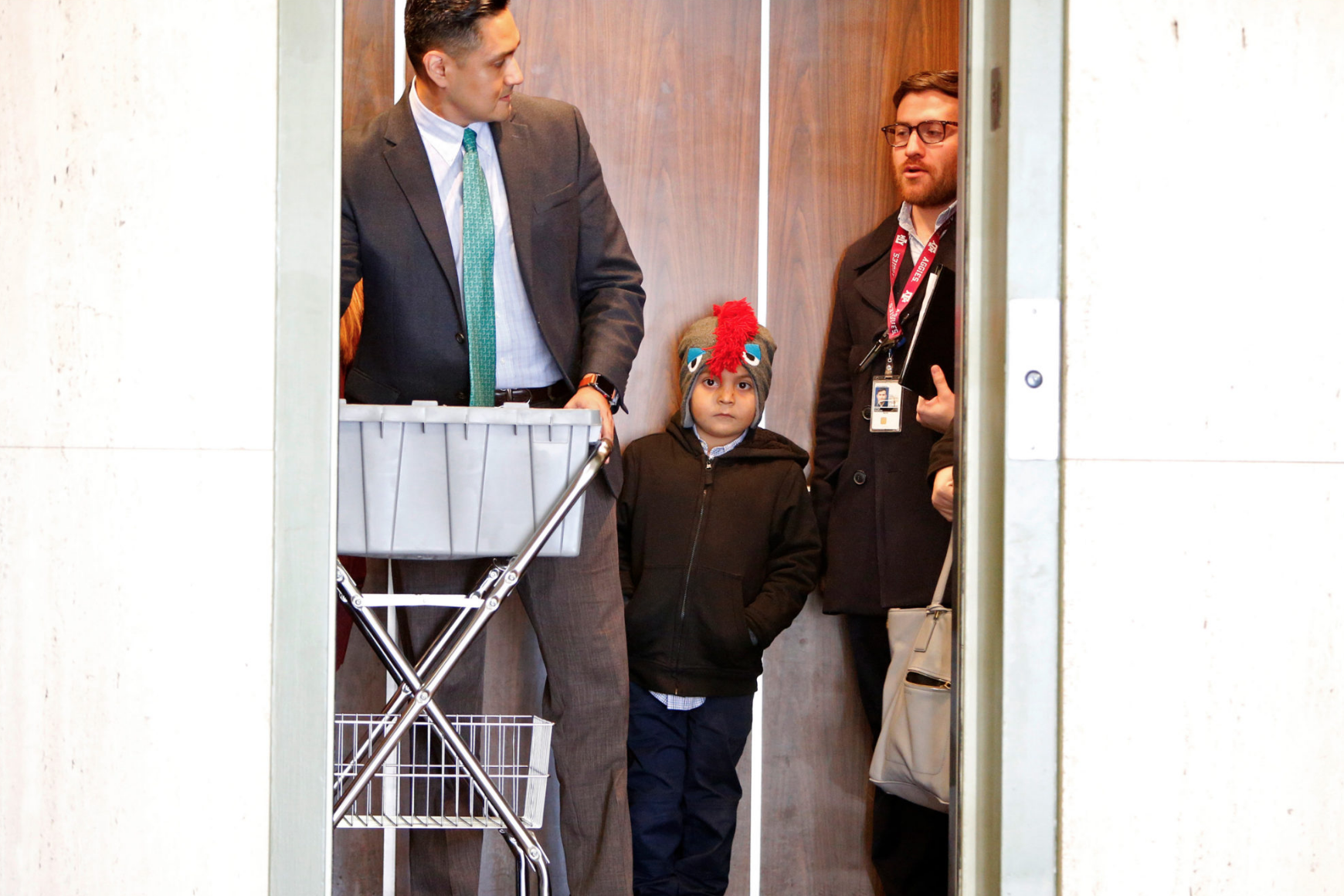

From Instagram: It’s a painful photo and a heart-wrenching commentary on the use of children as political pawns. Here you see Wilder Hilario Maldonado entering court for a detention hearing in San Antonio on his own. He also has no legal representation. One of the kids separated from his family under the government’s “zero tolerance” policy, the 6-year-old Salvadoran was being held in federal custody at an immigration detention facility about an hour away. Luckily, a lawyer at the hearing volunteered to stand in for him. The photo and the backstory are from an article on zero tolerance by ProPublica. That he’s sandwiched in there with the bin and actually wearing two extra eyes makes it all the more sad. (Michael Shaw)
Photo: Edward Ornelas for ProPublica Caption: Salvadoran immigrant Wilder Hilario Maldonado Cabrera, center, and others enter the building for an immigration court hearing in San Antonio.
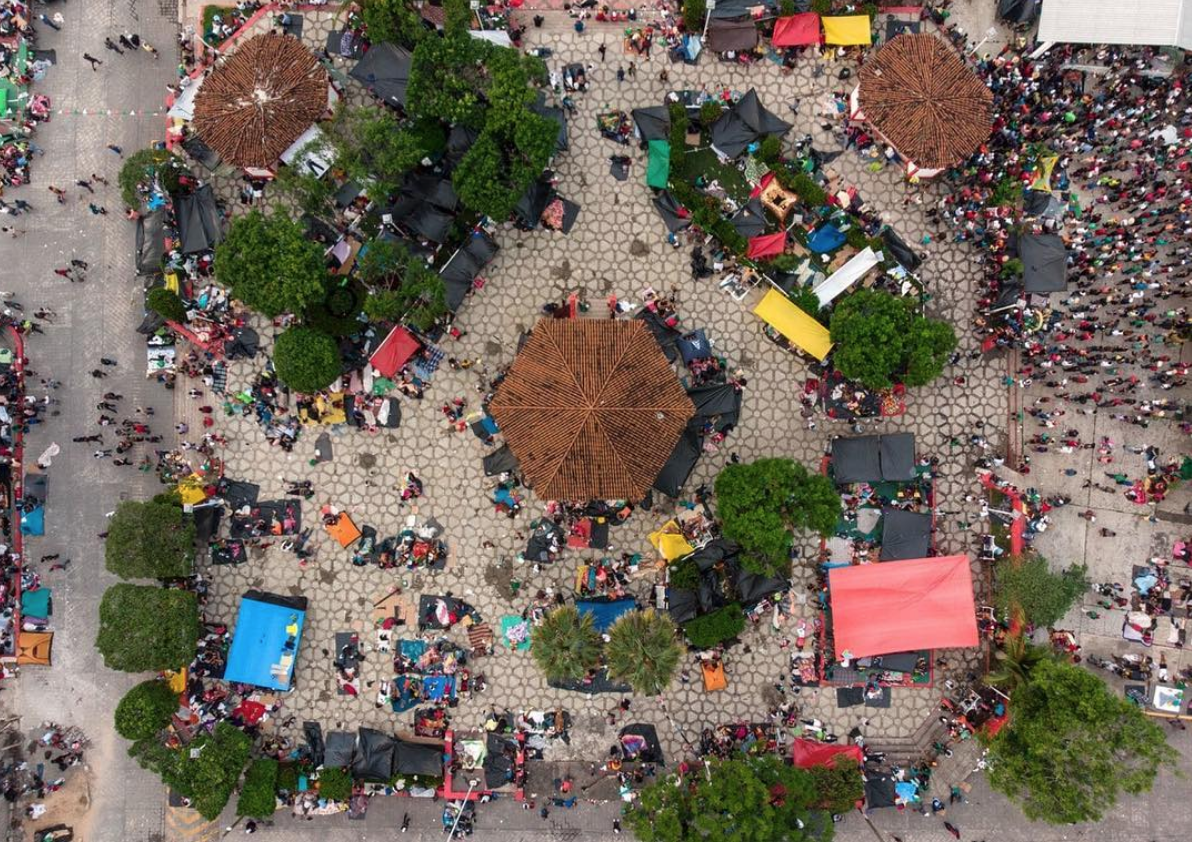

From Instagram: This is a photo of Hondurans camping out during the recent northward caravan. Taken by Guillermo Arias and distributed by AFP, it is set in the main square of San Pedro Tapanatepec in Oaxaca in southeastern Mexico. If you’ve been following the migrant story, you probably noticed how many photos have been taken from the air. In this case, the aerial frame almost turns the scene into abstract art. There is a benefit and also a risk in that. There is an opportunity to convey the scale, or the physical and cultural geography of the migration, in a truly novel way. On the other hand, there is the risk of reducing a dire situation into kaleidoscope wonder. When we come upon a photo like this, the question we ask ourselves is: how much does the photo leave the media consumer more informed than captivated? (Meg Handler)
Photo: Guillermo Arias/AFP/Getty Images Caption: Honduran migrants camps at the main square of San Pedro Tapanatepec on Oct. 28. 2018
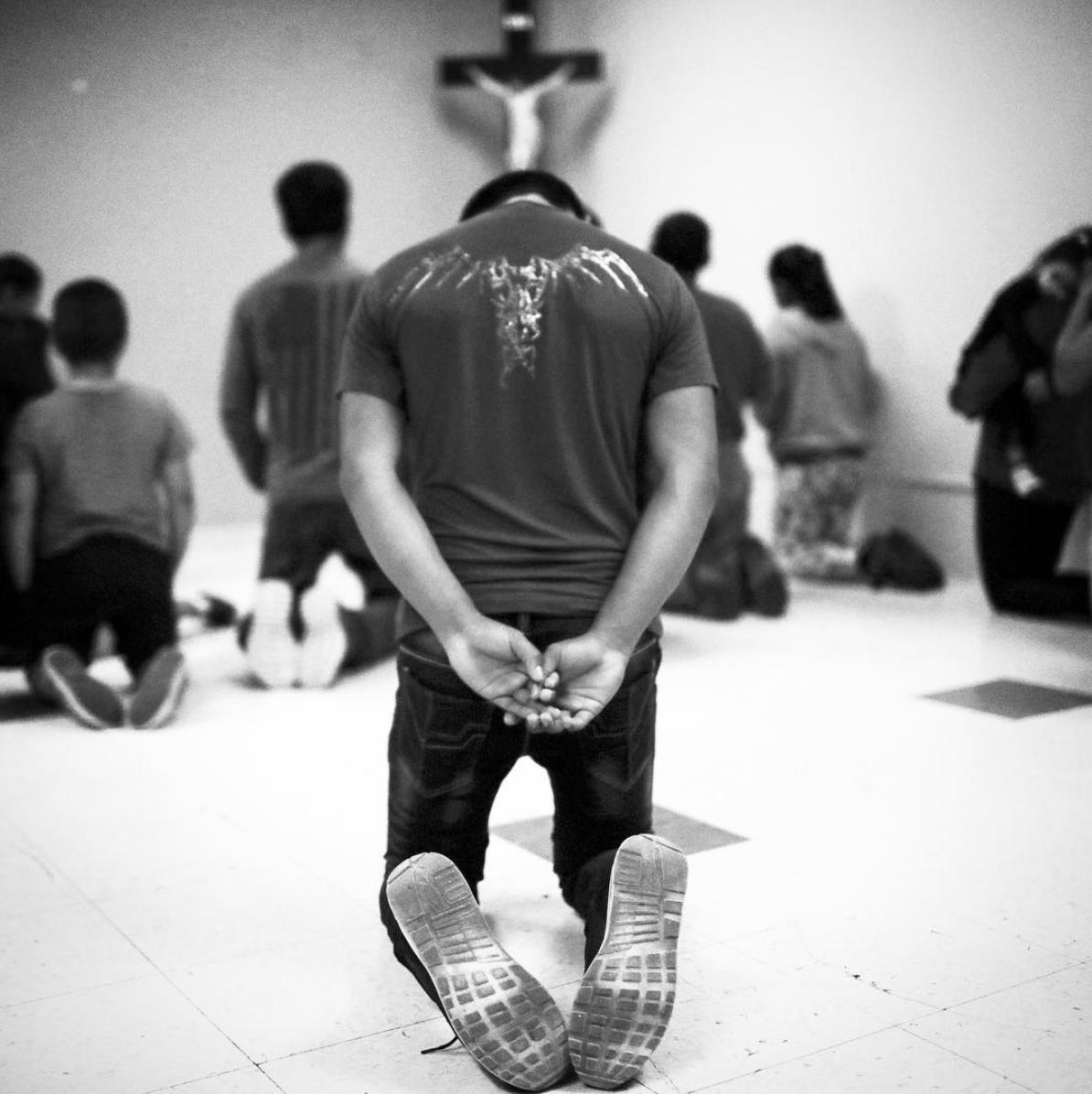

From Instagram: The way desperate immigrants and asylum seeking are being demonized as criminals, this body language is surely loaded. (But I imagine Mario Tama realized that as soon as he saw this man praying at the Annunciation House shelter for migrants in El Paso.) What makes the scene a lot more charged, however, is what’s been happening at the shelter these days. Annunciation House says it is receiving over 700 migrants a week who have just been released from ICE holding cells after having been captured crossing the border. Given those facts, the connection between kneeling to be handcuffed and bowing before God is not difficult to make. (Michael Shaw)
Follow us on Instagram (@readingthepictures) and Twitter (@readingthepix), and subscribe to our newsletter.
Topic
A curated collection of pieces related to our most-popular subject matter.
Panelists
Moderator, Assistant Professor, Communication Arts and Sciences, Penn State University. Ann Demo studies visual and digital advocacy. Her research has examined photography in early environmentalism, feminist art activism, and the immigrant rights movement.
Teddy Cruz is a professor of Public Culture and Urbanization in the Department of Visual Arts at the University of California, San Diego. He is known internationally for his urban research on the Tijuana/San Diego border, advancing border neighborhoods as sites of cultural production from which to rethink urban policy, affordable housing, and public space.
Show AllAssociate Professor of Political Science / Co-Director, UCSD Center on Global Justice. Fonna Forman is a political theorist and founding Director of the UCSD Center on Global Justice. Her research engages issues at the intersection of ethics, public culture, urban policy and the city – including human rights, climate justice and border ethics.
Senior Fellow at the Schuster Institute for Investigative Journalism. Erin writes, reports, produces, and consults for a variety of media outlets and publications. Based on the U.S-Mexico border in Tijuana, Mexico, her work currently focuses on the intersections of human rights, immigration policy, and border issues.
Staff Photographer, Arizona Republic. Nick specializes in social issues such as immigration and children’s care. He was a member of the the 2017 Pulitzer Prize-winning Arizona Republic/USA Today team that created the multimedia series, THE WALL.
Documentary photographer. For the past six years, San Martin has documented the U.S.-Mexico border, focusing on the issues of immigration, deportation, inequality and human rights abuses. Her photography and video projects have been featured in publications such as The Washington Post, The New York Times, and California Sunday Magazine.
Michael Shaw
Publisher, Reading The Pictures. An analyst of news photos and visual journalism, and a frequent lecturer and writer on visual politics, photojournalism and media literacy, Michael is the founder of Reading the Pictures.
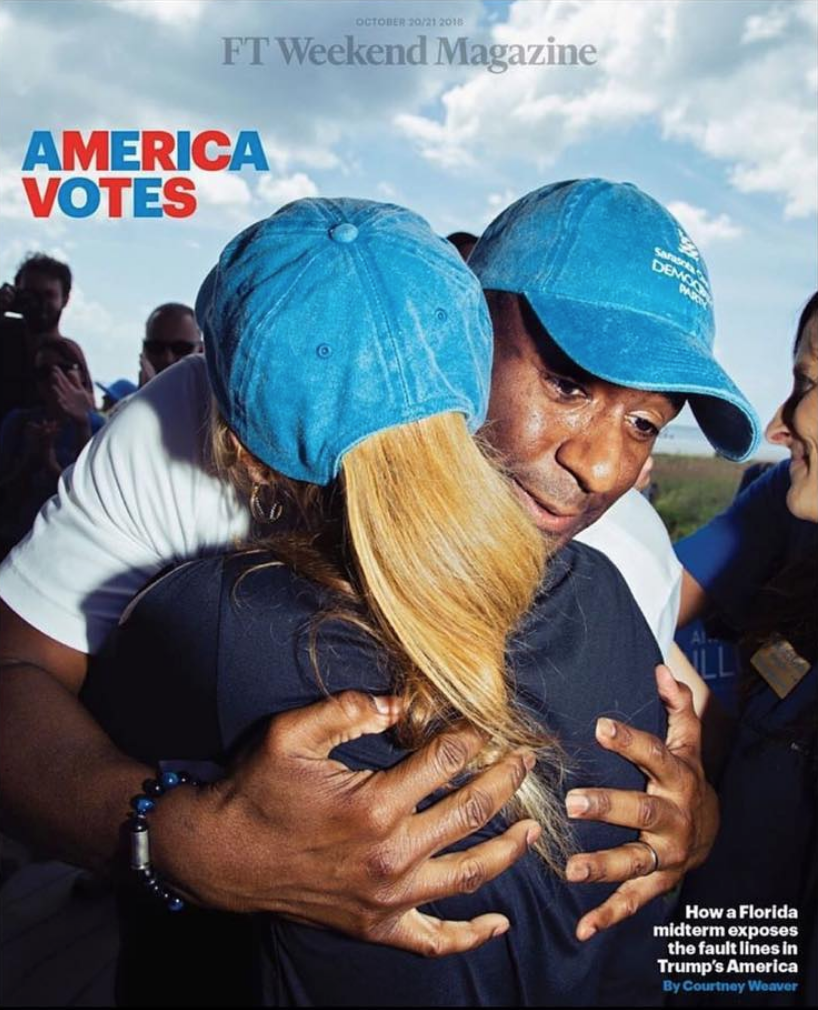
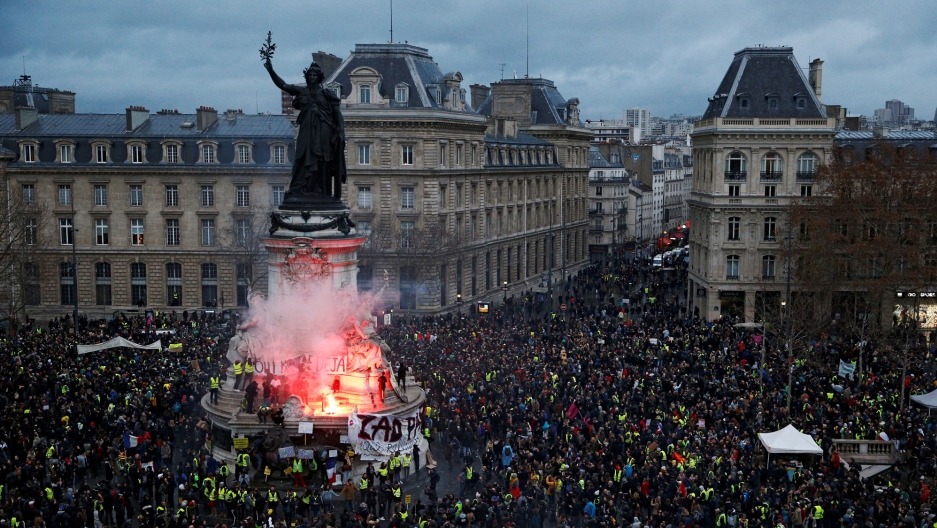

Reactions
Comments Powered by Disqus